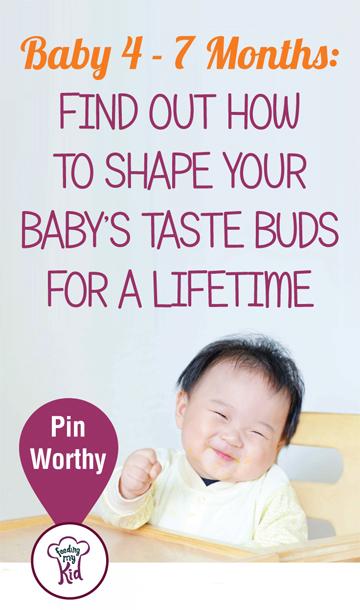 Picky eating is so incredibly common in the US. What if it didn’t have to be? What if you could reduce your child’s chances of becoming a picky eater? Would you try?
Picky eating is so incredibly common in the US. What if it didn’t have to be? What if you could reduce your child’s chances of becoming a picky eater? Would you try?
How?
Start Introducing Tastes to Your Baby at 4 Months
New research shows that babies are most receptive and accepting of new flavors between 4-7 months of age. Before your child become a fussy eater, teach him to taste.
“From four to seven months, it seems that there is a window when humans are extraordinarily receptive to flavor, but by following current guidelines on exclusive breastfeeding, parents tend to miss it. Several studies have shown that when vegetables are introduced at this age, babies are more open-minded,” according to author Bee Wilson from her book, First Bite.
Great book by the way. I would highly recommend it.
Wilson continues to say, “It takes fewer exposures to persuade them to like a new flavor, and the effects are long-lasting.” In fact, it can take up to 20+ exposures for a baby to grow to like a food; by exposing taste early, it can take less time for your baby to like food.
But be sure to wait to completely introduce solids until 6 months or until your baby is ready.
You should speak with your Pediatrician before introducing solids. Most Pediatricians, the CDC and the World Health Organization (WHO) recommend waiting until the baby is six months old until you introduce solids.
Let’s Clarify How To Do Both
 Well that’s conflicting advice, isn’t it? Let me clarify!
Well that’s conflicting advice, isn’t it? Let me clarify!
Despite what the WHO says about introducing foods after 6 months, introducing foods before has positive effects that will play out for the rest of your little one’s life, from childhood to adulthood (2). It can determine whether you have a picky eater, their eating habits and in the long run, it can determine their identity.
As Bee Wilson said about the World Health Organization’s decision:
“…It’s not that a child necessarily needs any nutrition besides milk before 6 months, it’s that you’re missing an opportunity to introduce them to all of these flavors which they would likely accept at this age” (2).
When Introducing Solids to Babies
 You can start introducing tastes to your baby as young as 4 months – not meals. This just means dip your finger in whatever you have prepared for the family and let your baby taste the food. You can also start by thinning out the baby food with breast milk or your formula. This way they are being introduced to the foods in a way that they recognize. Offer multiple tastes per meal.
You can start introducing tastes to your baby as young as 4 months – not meals. This just means dip your finger in whatever you have prepared for the family and let your baby taste the food. You can also start by thinning out the baby food with breast milk or your formula. This way they are being introduced to the foods in a way that they recognize. Offer multiple tastes per meal.
The amount you feed your baby while breastfeeding should stay the same, even though you are introducing new foods to them. Start introducing vegetables, fruits, some meats, and beans. Try to give them a lot of variety!
Wilson continues in her book to say, “the flavor window is only fully open for a short time, and it seems to begin closing even at the age of 4-6 months. A 2014 study found that when babies were introduced to a single vegetable at six months, pea-puree, they ate significantly less of it than babies who were introduced to a range of purees at four months.”
When you decide to introduce these foods to babies, please make sure that you continue breastfeeding. You’re just giving them a taste.
Whatever you do, don’t transition your little one to cow’s milk until after they are a year old (unless recommended by a doctor). Check out our article on everything you need to know
Be sure to avoid honey and salt. Avoid honey because it can cause botulism
So if you want an adventurous eater who will try the foods you want them to eat, like fruits, veggies, and all the other healthier options, be sure to allow your child the ability to experience new flavors before 6 months. You’ll be on the road to success, helping to develop positive relationships between your little one and the food he eats!
Here is a great list of baby finger foods! There are so many foods that can be turned into the perfect foods for your baby.
Related Reading:
-
-
- Six Feeding Tips For Parents with Infants Turning Six Months
- Introducing First Foods to Your Baby: What I wish someone told me [Part 1]
- Introducing First Foods to Your Baby: What I wish someone told me [Part 2]
- Baby 4 – 7 Months: Find Out How to Shape Your Baby’s Taste Buds For a Lifetime
- Your Ultimate Guide to Introducing First Food to Your Baby
- Is My Child’s Eating Normal at 9-12 Months of Age? Find Out What’s Normal.
- Childhood BMI Can Predict Obesity Starting at Early as 6 Months
-
Temperament Plays a Role In Picky Eating Too
These methods are the best safeguard in creating an adventurous foodie, but they are only preventative and can only do so much. It’s important to note that there is still a possibility that you could end up with a picky eater. It could all depend on the temperament of your child. A more reserved child can be more cautious about trying new foods.
Children who suffer from autism, sensory processing disorder, anxiety, allergies or other medical conditions can also be picky eaters even if you gave them a million tastes of food between 4-7 months. This doesn’t mean you shouldn’t try, this is the first step in creating a healthy lifestyle for your child and your family!
For more on teaching kids to eat healthily, check out these articles:
- Video: What I wish someone told me when I was introducing first foods to my twins Part I and Part II
- How to Get Your Picky Eater to Eat Healthier
- Introducing Solids to My Baby: Baby Feeding Milestones By Month
- Introducing Solid Foods to Baby: Allergy Awareness
- Baby Finger Food Recipes
- What to Expect When Your Baby is 9-12 Months Old (Be Sure to Read this One Next)

Citations:
1. Illinois New Bureau: Breastfed babies less likely to be picky eaters as toddlers
2. NPR: In Baby’s ‘First Bite,’ A Chance To Shape A Child’s Taste
3. Baby Center: Developmental Milestones: Taste
4. Baby Center: No more waiting: Offer a variety of foods early
The information on this website is designed for educational and/or entertainment purposes only. The information provided is not intended to be a substitute for informed medical advice or care. Please consult a doctor with any questions or concerns regarding your child’s condition. You should not use this information to diagnose or treat any health problems or illnesses.
This post contains affiliate links through Amazon. If you purchase a product through this link, your cost will be the same, but I will receive a small commission to help with operating costs of this blog. Thanks for your support! We have hand curated all of our products to make selecting the right products for your family easier.

